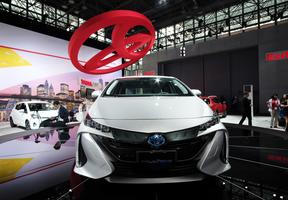Three Simple Mobility Exercises on Mobility
10 min read
Mobility means getting from one place to another, using different means of transportation, at different speeds, and with fuels emitting different amounts of pollution or CO2. Here are three exercises to help you understand how these variables interact.

© Getty
Exercice niveau 1 / Exploring
The Faster You Go, the More Fuel You Consume!
This exercise shows the correlation between speed and fuel consumption.
Whether you’retalking about a scooter, a motorbike, a car, a plane or a motorboat, fuel consumption rises with speed. For two-wheelers and cars, other factors push up fuel consumption too, such as under-inflated tires and heavy loads (especially if they’re placed on the roof of the car and increase its air resistance, or “drag”).
The table below shows an average car’s fuel consumption in liters (L) when driving 100 kilometers (km) on a flat road.
| Speed | 70 km/h | 100 km/h | 130 km/h |
| Consommation (per 100km) | 6 L | 8 L | 12 L |
To go from 70 kilometers per hour (km/h) to 100 km/h, i.e., 30 km/h faster, you consume 2 liters more of fuel. So, to go from 100 km/h to 130 km/h – another 30 km/h faster – how much more fuel will you consume?
4 liters more. That’s double what it took to get from 70 km/h to 100 km/h.
Level 2 Exercise / Tell me more:
The Solar Airplane, Featherweight World Champion
This exercise shows hows how, without using fuel, Solar Impulse 2 flew around the world in 2015 and 2016.
Between 2015 and 2016, the Solar Impulse 2 aircraft completed a round-the-world trip in 17 stages, with a pilot on board, and no fuel – in other words, using only the generated by the solar panels on its wings.
Below are the main specifications provided by the project leaders, Bertrand Piccard and André Borschberg. Visit their website: https://aroundtheworld.solarimpulse.com/adventure
| Wingspan | 72 m |
| Weight | 2.3 metric tons |
| Number of solar cells | 2.3 metric tons |
| Number of propellers and batteries | 4 |
| Total energy produced | 11,655 kWh |
| Maximum flight time | 117 hours 52 minutes |
| Maximum altitude | 8,500 m |
| Maximum ground speed | 216 km/h |
| Fuel consumption | 0 L |
Solar Impulse is a magnificent demonstration and a great human adventure, but not a prototype aircraft that could carry passengers and freight. There are electric airplanes in development, but they have batteries that are recharged on land, via the grid. Solar Impulse recharges its batteries in flight, using the sun.
With more than 17,000 solar cells spread across its 270-square-meter (sq.m) wings (a wingspan equal to an airliner), Solar Impulse generated a maximum of 340 kilowatt-hours (kWh) per day. For an airplane to take off and fly using such little energy, it has to be very light. Solar Impulse weighs the same as a van. A small aircraft like a “Piper Cub” is admittedly lighter, coming in at 300 kilograms (kg), but its wings are too small to be solar-powered!
Of the cumulative 550 hours flown over the 17 stages, total power generation was nearly 12,000 kWh
Given that a high-speed train, which carries 350 passengers, consumes an average of 20 kWh per kilometer, how far could it travel with the same amount of electricity that allowed Solar Impulse to fly around the world? 1) 300 km 2) 600 km 3) 900 km
With 12,000 kWh, a high-speed train could travel approximately 600 km. That’s roughly the distance between Paris and Geneva. The featherweight Solar Impulse traveled exactly 43,000 km using the same amount of energy.
Level 3 Exercise / Going In Depths:
Heavy-Weight Category: Container Ships!
This exercise compares the CO2 emission of a carrier to that of a truck. The answer will surprise you!

Heavy-Weight Category: Container Ships! Container ships are the largest form of transportation in the world. The image above shows the size of the world’s biggest container ship, the Jacques Saadé, compared with a semi-trailer, an airliner and a military aircraft carrier.
Typically powered by , these giants of the sea emit dangerous particles, such as sulfur and nitrogen oxides. The gradual switch to as fuel should considerably mitigate this problem. But the question remains: Are container ships also “monsters” in terms of emissions when measured against other means of freight transportation?
To compare them with the many options available, we have to look at emissions per “ton-kilometer” (how much CO2 is emitted when moving a metric ton one kilometer).
A giant container ship[1] emits around 3 grams (g) of CO2 per ton-kilometer. If it is carrying a load of 200,000 metric tons, it will therefore emit 600 kg of CO2 per km.
A 40-ton container semi-trailer, common on European roads, produces more than 90 g of CO2 per ton-kilometer. The 40-ton vehicle will therefore emit 3.6 kg of CO2 per km.
By way of comparison, rail transportation emits between 1.5 g and 35 g of CO2 per ton-kilometer (depending on the energy source used) and air transportation between 670 g and 3,000 g per ton-kilometer (depending on flight conditions).
Between a container ship and a truck, which produces the least CO2 relative to the load being transported ?
The giant container ship. Transporting the 200,000 metric tons of product that can be packed onto a container ship would require a huge convoy of 5,000 trucks. A container ship with a load this size would emit 600 kg of CO2 per kilometer, whereas 5,000 trucks would emit 18 metric tons. However, it’s important to remember that the two means of transportation (sea and land) are not interchangeable, meaning they both typically need to be used.





















